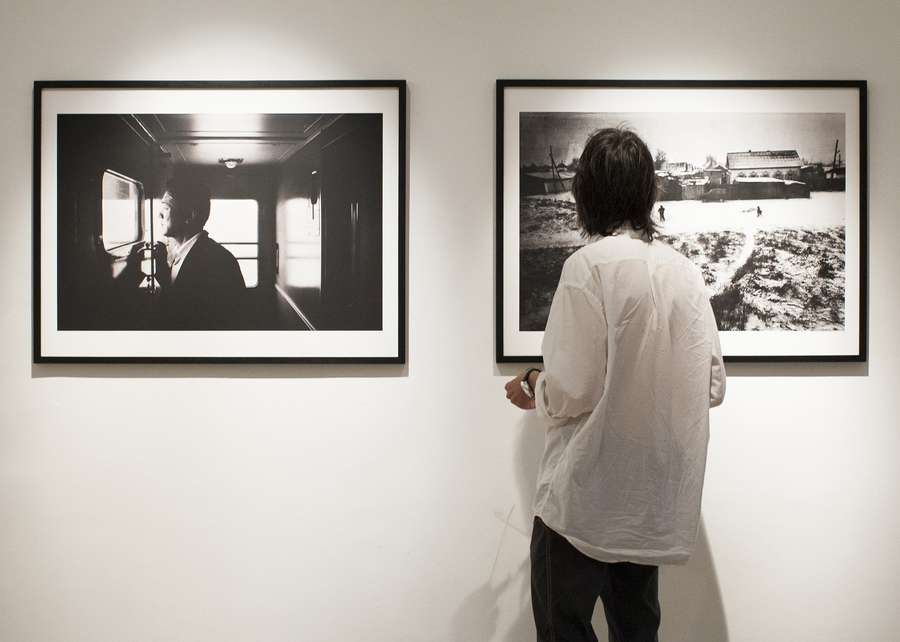Klavdij Sluban: East to East
Klavdij Sluban's exhibition East to East brings together photographs that he has made during extensive travels in the East, frequently following the route of the Trans-Siberian Railway. Sluban's use of deep blacks and backlit silhouettes embues his work with a highly individual photographic style. These powerful images are remarkably moody and atmospheric and permeated with a strange melancholy and an overwhelming sense of isolation.
Winner of the European Publishers Award for Photography 2009, of the Leica Prize (2004) and of the Niépce Prize, main French prize in photography, (2000), Klavdij Sluban is a French photographer of Slovenian origin born in Paris in 1963. He develops a rigorous and coherent body of work, never inspired by immediate and sensational current affairs, making him one of the most interesting photographers in so-called "author-photography". The Balkans, the Black Sea, the Baltic Sea, the Caribbean, Central America, Russia, China can be read as many successive steps of an in-depth study of a patient proximity to the encountered real. His images are on show in such leading institutions as the Metropolitan Museum of Photography of Tokyo, the Maison Européenne de la Photographie in Paris, the Museum of Photography in Helsinki, the Fine Arts Museum in Canton...
His many books include Entre Parenthèses (Photo Poche, Actes Sud), Transverses (Maison Européenne de la Photographie), Balkans -Transit, with a text by François Maspero (Le Seuil) and East to East, with a text by Erri de Lucca. Since 1995, Sluban runs photography workshops with young offenders in prison. First originated in France, in the prison of Fleury-Mérogis with support from Henri Cartier Bresson, Marc Riboud and William Klein, this commitment was pursued in the disciplinary camps and prisons of Eastern Europe – Serbia, Slovenia, Ukraine, Georgia, Moldavia, Latvia – and in the disciplinary centres of Moscow and St Petersburg, and lately in Ireland and Central America (Guatemala and Salvador).
"... the journey of the photographer, rather than leading him to an East that is conceived as time past, opens a crack in the wall of time and takes him into the future. He visits the East as if he were a pilgrim consulting an oracle. From it he receives visions veiled in smoke and mist: the East is a defeated future, a time yet to come for humanity, stretched out and flexing, as if it were a tail, still wagging, if only feebly. The tail, as every butcher knows, is the hardest part to skin. And the future depicted here in photographic images is hard, hard to listen to. From the noisiest century of all, the greatest producer of mechanical clatter, we shall pass into a world of silence. The future will be accompanied by the silence of those who have been struck dumb. In these photographs, the use of black and white is like the fitting of a silencer to the barrel of a gun. The photographer is a marksman. The rumble of escalators, nuclear power stations, trains and urban landscapes breaks up into whispers.
The photographer is homesick for the native snow of his childhood, the snow that used to blanket his corner of the world. But here it has become a white leprosy; it doesn’t coat the ground but eats away at it. Its silence is oppressive. Occasionally the photographer uses a fast exposure to capture a movement, a sudden rush. More often he uses a long exposure and a very small aperture, so that the image is suffused with silence. To give subjects stillness a longer exposure is required. Stillness is the state of grace of a messianic moment, not the thrill of a divine visitation, but the conclusion of a race ..."
—Erri de Lucca (from the monograph Klavdij Sluban: East to East)
The East to East in the Match Gallery is connected to the simultaneous exhibition Other Shores – The Baltic Sea in Galerija Fotografija.
Colophon
Production: Museum and Galleries of Ljubljana
Co-production: Galerija Fotografija
The project was made possible by: City of Ljubljana, French Institute in Ljubljana
Acknowledgement: Riko
Location
Trg francoske revolucije 7
1000 Ljubljana
T +386 1 24 12 590
T +386 1 24 12 500
E galerija.vzigalica@mgml.si
Opening hours
Tuesday–Sunday: 10 a.m.–6 p.m.
Monday: Closed
1 January, 1 November, 25 December: Closed
24 and 31 December: 10 a.m.–2 p.m.
Tickets
Free entry.
